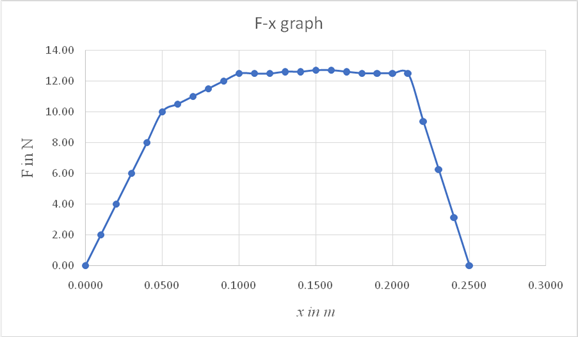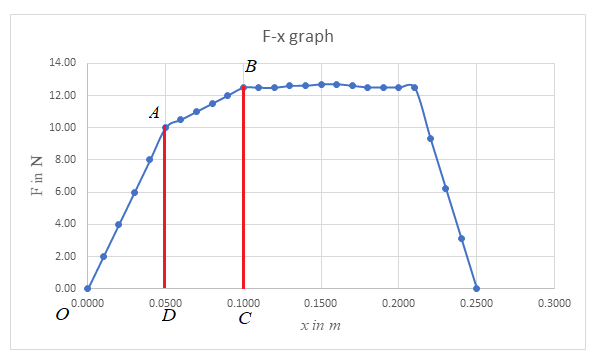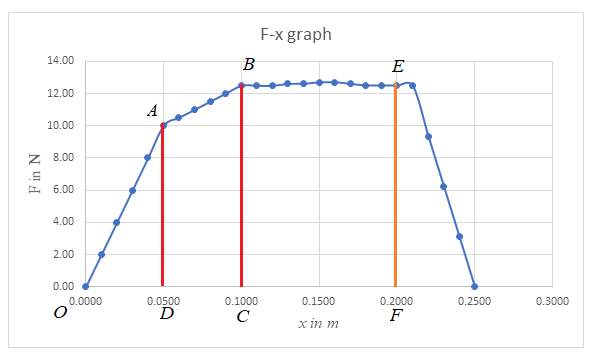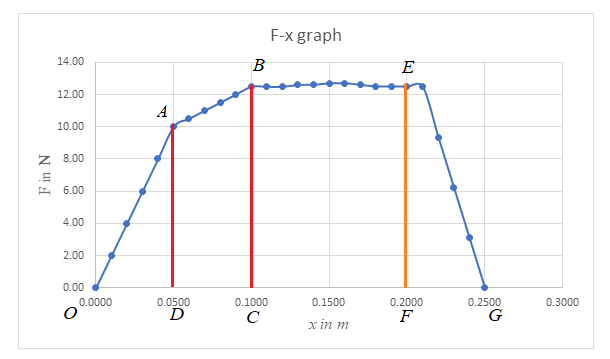
Concept explainers
(a)
The work done in the first 0.100 m by plotting a graph between F and x.
Answer to Problem 37QAP
The work done in the first 0.100 m is 0.812 J.
Explanation of Solution
Given:
The values of x and F.
| x (m) | F (N) |
| 0.0000 | 0.00 |
| 0.0100 | 2.00 |
| 0.0200 | 4.00 |
| 0.0300 | 6.00 |
| 0.0400 | 8.00 |
| 0.0500 | 10.00 |
| 0.0600 | 10.50 |
| 0.0700 | 11.00 |
| 0.0800 | 11.50 |
| 0.0900 | 12.00 |
| 0.1000 | 12.48 |
| 0.1100 | 12.48 |
| 0.1200 | 12.48 |
| 0.1300 | 12.60 |
| 0.1400 | 12.60 |
| 0.1500 | 12.70 |
| 0.1600 | 12.70 |
| 0.1700 | 12.60 |
| 0.1800 | 12.50 |
| 0.1900 | 12.50 |
| 0.2000 | 12.50 |
| 0.2100 | 12.48 |
| 0.2200 | 9.36 |
| 0.2300 | 6.24 |
| 0.2400 | 3.12 |
| 0.2500 | 0.00 |
Formula used:
Using an excel sheet, a graph is plotted between F and x and the work done is calculated by determining the area under the curve for the displacement under consideration.
Calculation:
Enter the values of x and F in an excel sheet and plot a graph as shown below.

For the displacement of 0.1 s, calculate the area under the curve.

The work done during the displacement of 0.1 s is equal to area OABC.
Calculate the area of the figure OABC.
Substitute the values of the variables from the graph in the above equation.
Conclusion:
Thus, the work done in the first 0.100 m is 0.812 J.
(b)
The work done in the first 0.200 m by plotting a graph between F and x.
Answer to Problem 37QAP
The work done in the first 0.200 m is 2.06 J.
Explanation of Solution
Given:
The values of x and F.
| x (m) | F (N) |
| 0.0000 | 0.00 |
| 0.0100 | 2.00 |
| 0.0200 | 4.00 |
| 0.0300 | 6.00 |
| 0.0400 | 8.00 |
| 0.0500 | 10.00 |
| 0.0600 | 10.50 |
| 0.0700 | 11.00 |
| 0.0800 | 11.50 |
| 0.0900 | 12.00 |
| 0.1000 | 12.48 |
| 0.1100 | 12.48 |
| 0.1200 | 12.48 |
| 0.1300 | 12.60 |
| 0.1400 | 12.60 |
| 0.1500 | 12.70 |
| 0.1600 | 12.70 |
| 0.1700 | 12.60 |
| 0.1800 | 12.50 |
| 0.1900 | 12.50 |
| 0.2000 | 12.50 |
| 0.2100 | 12.48 |
| 0.2200 | 9.36 |
| 0.2300 | 6.24 |
| 0.2400 | 3.12 |
| 0.2500 | 0.00 |
Formula used:
Using an excel sheet, a graph is plotted between F and x and the work done is calculated by determining the area under the curve for the displacement under consideration.
Calculation:
The F-x graph is shown below:

The work done during the displacement of 0.200 m is given by the area OABEF.
Assume an average value of Force as 12.50 N during the displacement from 0.100 m to 0.0200 m.
Substitute the values of the variables from the graph in the above equation.
Conclusion:
Thus, the work done in the first 0.200 m is 2.06 J.
(c)
The work done during the displacement from 0.100 m to 0.200 m by plotting a graph between F and x.
Answer to Problem 37QAP
The work done during the displacement from 0.100 m to 0.200 m is 1.25 J.
Explanation of Solution
Given:
The values of x and F.
| x (m) | F (N) |
| 0.0000 | 0.00 |
| 0.0100 | 2.00 |
| 0.0200 | 4.00 |
| 0.0300 | 6.00 |
| 0.0400 | 8.00 |
| 0.0500 | 10.00 |
| 0.0600 | 10.50 |
| 0.0700 | 11.00 |
| 0.0800 | 11.50 |
| 0.0900 | 12.00 |
| 0.1000 | 12.48 |
| 0.1100 | 12.48 |
| 0.1200 | 12.48 |
| 0.1300 | 12.60 |
| 0.1400 | 12.60 |
| 0.1500 | 12.70 |
| 0.1600 | 12.70 |
| 0.1700 | 12.60 |
| 0.1800 | 12.50 |
| 0.1900 | 12.50 |
| 0.2000 | 12.50 |
| 0.2100 | 12.48 |
| 0.2200 | 9.36 |
| 0.2300 | 6.24 |
| 0.2400 | 3.12 |
| 0.2500 | 0.00 |
Formula used:
Using an excel sheet, a graph is plotted between F and x and the work done is calculated by determining the area under the curve for the displacement under consideration.
Calculation:
The F-x graph is shown below:

The work done during the displacement from 0.100 m to 0.200 m is given by the area BEFC.
Assume an average value of Force as 12.50 N during the displacement from 0.100 m to 0.0200 m.
Substitute the values of the variables from the graph in the above equation.
Conclusion:
Thus, the work done during the displacement from 0.100 m to 0.200 m is 1.25 J.
(d)
The work done during the entire motion
Answer to Problem 37QAP
The work done during the entire motion
Explanation of Solution
Given:
The values of x and F.
| x (m) | F (N) |
| 0.0000 | 0.00 |
| 0.0100 | 2.00 |
| 0.0200 | 4.00 |
| 0.0300 | 6.00 |
| 0.0400 | 8.00 |
| 0.0500 | 10.00 |
| 0.0600 | 10.50 |
| 0.0700 | 11.00 |
| 0.0800 | 11.50 |
| 0.0900 | 12.00 |
| 0.1000 | 12.48 |
| 0.1100 | 12.48 |
| 0.1200 | 12.48 |
| 0.1300 | 12.60 |
| 0.1400 | 12.60 |
| 0.1500 | 12.70 |
| 0.1600 | 12.70 |
| 0.1700 | 12.60 |
| 0.1800 | 12.50 |
| 0.1900 | 12.50 |
| 0.2000 | 12.50 |
| 0.2100 | 12.48 |
| 0.2200 | 9.36 |
| 0.2300 | 6.24 |
| 0.2400 | 3.12 |
| 0.2500 | 0.00 |
Formula used:
Using an excel sheet, a graph is plotted between F and x and the work done is calculated by determining the area under the curve for the displacement under consideration.
Calculation:
The F-x graph is shown below:

The work done during the entire displacement is given by the area OABEG.
Substitute the values of the variables from the graph in the above equation.
Conclusion:
Thus, the work done during the entire motion
Want to see more full solutions like this?
Chapter 6 Solutions
COLLEGE PHYSICS,VOLUME 1
- Suppose you have a diverging lens with a focal length of - 25 cm. You look through this lens at a sleeping squirrel, and notice that it forms a virtual image of the squirrel with di = - 18 cm. How far away from the lens is the squirrel? Give your answer as the number of centimeters (a positive number).arrow_forwardDiamond has an index of refraction of about 2.4. Suppose you cut a diamond so it has a flat surface, and shine a laser pointer beam so that it makes a 27 degree angle with respect to the normal line to that surface. What angle will the laser beam make with respect to the normal after it passes through the air-diamond boundary and is inside the diamond? Give your answer as the number of degrees.arrow_forwardFind current of each line of D,E, and F. Where V1 is 9V, V2 is 7V, R1 is 989 , R2 is 2160, R3 is 4630 , R4 is 5530, R5 is 6720, and E is 16V. Please explain all steps. Thank youarrow_forward
- You are tasked with designing a parallel-plate capacitor using two square metal plates, eachwith an area of 0.5 m², separated by a 0.1 mm thick layer of air. However, to increase the capacitance,you decide to insert a dielectric material with a dielectric constant κ = 3.0 between the plates. Describewhat happens (and why) to the E field between the plates when the dielectric is added in place of theair.arrow_forwardCalculate the work required to assemble a uniform charge Q on a thin spherical shell of radiusR. Start with no charge and add infinitesimal charges dq until the total charge reaches Q, assuming thecharge is always evenly distributed over the shell’s surface. Show all steps.arrow_forwardRod AB is fixed to a smooth collar D, which slides freely along the vertical guide shown in (Figure 1). Point C is located just to the left of the concentrated load P = 70 lb. Suppose that w= 17 lb/ft. Follow the sign convention. Part A Figure 3 ft -1.5 ft √30° 1 of 1 Determine the normal force at point C. Express your answer in pounds to three significant figures. ΜΕ ΑΣΦ Η vec Nc= Submit Request Answer Part B Determine the shear force at point C. Express your answer in pounds to three significant figures. VC= ΜΕ ΑΣΦΗ vec Submit Request Answer Part C Determine the moment at point C. Express your answer in pound-feet to three significant figures. Mc= Ο ΑΣΦ Η vec Submit Request Answer Provide Feedback ? ? lb lb ? lb-ftarrow_forward
- Consider a uniformly charged ring of radius R with total charge Q, centered at the origin inthe xy-plane. Find the electric field (as a vector) at a point on the z-axis at a distance z above thecenter of the ring. Assume the charge density is constant along the ring.arrow_forward3) If the slider block C is moving at 3m/s, determine the angular velocity of BC and the crank AB at the instant shown. (Use equation Vs Vc wx fuc, then use equation Vs VA + Ve/athen write it in terms of w and the appropriate r equate the two and solve) 0.5 m B 1 m 60° A 45° vc = 3 m/sarrow_forward3) If the slider block C is moving at 3m/s, determine the angular velocity of BC and the crank AB at the instant shown. (Use equation Vs Vc wxf, then use equation V, VA + Va/Athen write it in terms of w and the appropriate r equate the two and solve) f-3marrow_forward
- Pls help ASAParrow_forwardPls help ASAParrow_forward14. A boy is out walking his dog. From his house, he walks 30 m North, then 23 m East, then 120 cm South, then 95 m West, and finally 10 m East. Draw a diagram showing the path that the boy walked, his total displacement, and then determine the magnitude and direction of his total displacement.arrow_forward
 University Physics Volume 1PhysicsISBN:9781938168277Author:William Moebs, Samuel J. Ling, Jeff SannyPublisher:OpenStax - Rice University
University Physics Volume 1PhysicsISBN:9781938168277Author:William Moebs, Samuel J. Ling, Jeff SannyPublisher:OpenStax - Rice University Principles of Physics: A Calculus-Based TextPhysicsISBN:9781133104261Author:Raymond A. Serway, John W. JewettPublisher:Cengage Learning
Principles of Physics: A Calculus-Based TextPhysicsISBN:9781133104261Author:Raymond A. Serway, John W. JewettPublisher:Cengage Learning Glencoe Physics: Principles and Problems, Student...PhysicsISBN:9780078807213Author:Paul W. ZitzewitzPublisher:Glencoe/McGraw-Hill
Glencoe Physics: Principles and Problems, Student...PhysicsISBN:9780078807213Author:Paul W. ZitzewitzPublisher:Glencoe/McGraw-Hill College PhysicsPhysicsISBN:9781938168000Author:Paul Peter Urone, Roger HinrichsPublisher:OpenStax College
College PhysicsPhysicsISBN:9781938168000Author:Paul Peter Urone, Roger HinrichsPublisher:OpenStax College College PhysicsPhysicsISBN:9781305952300Author:Raymond A. Serway, Chris VuillePublisher:Cengage Learning
College PhysicsPhysicsISBN:9781305952300Author:Raymond A. Serway, Chris VuillePublisher:Cengage Learning College PhysicsPhysicsISBN:9781285737027Author:Raymond A. Serway, Chris VuillePublisher:Cengage Learning
College PhysicsPhysicsISBN:9781285737027Author:Raymond A. Serway, Chris VuillePublisher:Cengage Learning





